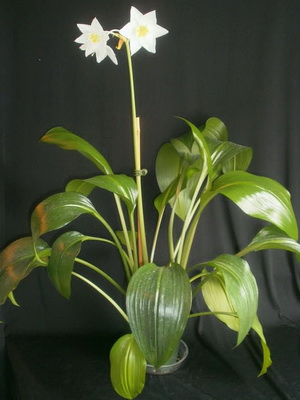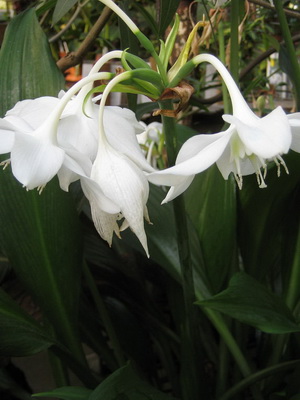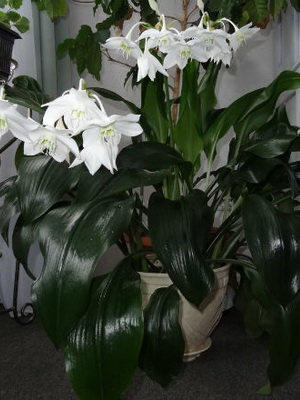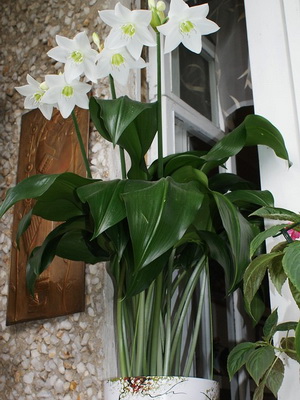What do we know about the "Amazon lily"?
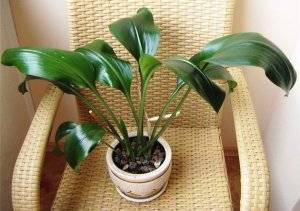 Eucharis or "Amazonian lily", called Eucharis in Latin, is a bulbous plant and belongs to the amaryllis family.
Eucharis or "Amazonian lily", called Eucharis in Latin, is a bulbous plant and belongs to the amaryllis family.
The homeland of eucharis is the tropical forests of South America. In the bosom of nature, the plant grows on loose, humus-rich soils in the shade of tall trees.
The undoubted advantage of eucharis is the large number of large dark green leaves on one plant, which can reach 40 cm in length. Magnificent foliage has been growing for more than one year and only partially dies off during dormancy, after which is replaced by the fallen leaves new ones grow.
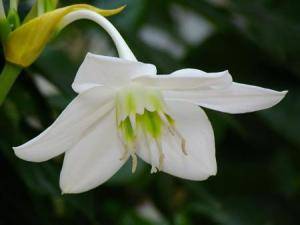 Eucharis in translation means "graceful", and this definition perfectly characterizes its beautiful flowers with snow-white petals, shaped like daffodils.
Eucharis in translation means "graceful", and this definition perfectly characterizes its beautiful flowers with snow-white petals, shaped like daffodils.
In the center of each flower there is a greenish crown with carved teeth along the edges, which gives a special charm.
With proper care, the plant blooms twice a year - in autumn and early spring. On one eucharis peduncle, up to 6 delicate flowers with a delicate aroma bloom.
Experienced growers are also striving for the third flowering of the "Amazonian lily", but for this it is necessary to keep it in almost ideal conditions.
In indoor floriculture, two types of Amazonian lilies are grown:
- Eucharis large-flowered or in Latin Eucharis grandiflora - this species is distinguished by large flowers, reaching 12 cm in diameter.
- Eucharis amazonian or in Latin Eucharis amazonian - this plant blooms with smaller flowers with a diameter of about 6 cm.
How to stimulate Eucharis bloom?
Important! Stimulation of flowering is possible only if all care recommendations are followed. Otherwise, stimulation will not help to achieve the desired effect .. Stimulation is performed with the drugs "Bud", "Blossom" or "Blossom"
Recommendations for the use of these drugs can be found on the packaging of these stimulants. We advise you to use the minimum dose for Eucharis. Stimulating drugs, like fertilizers, are applied to wet soil
Stimulation is carried out with the drugs "Bud", "Blossom" or "Blossom". Recommendations for the use of these drugs can be found on the packaging of these stimulants. We advise you to use the minimum dose for Eucharis. Stimulating drugs, like fertilizers, are applied to wet soil.
One of the drugs to stimulate the flowering of Eucharis.
Eucharis care
Eucharis or Amazonian lily is rightfully considered one of the most amazing and beautiful flowers. Its decorative effect does not fade throughout the year. Even when the plant is not in bloom, its large, dark green, glossy leaves adorn the home. If you once see how eucharis blooms, you probably want to purchase this amazing flower in your collection of indoor plants.
Homeland of the plant
For the first time, eucharis was discovered in the tropical rainforests of Central and South America, as well as in Colombia and the upper Amazon. The exotic flower came to Europe in the 19th century and immediately became a real decoration of many botanical gardens. It was then that the plant began to be called "Eucharis", which in translation means "the most charming", "graceful". To date, according to various sources, from 10 to 20 species of this plant have been recorded.
Eucharis appearance
Undoubtedly, the main decoration of the plant is its flowers. In shape, they resemble daffodils, they smell good. The diameter of one inflorescence is from 10 to 12 cm, the height of the peduncle reaches 70 cm.The color scheme is not very diverse: the vast majority of varieties form white inflorescences, but today breeders have bred varieties with cream and blue flowers.
Eucharis leaves are no less decorative than flowers: large, glossy, dark green and do not lose their decorative effect throughout the year. The dimensions of the leaf plate are quite impressive: length - 40 cm, width - 20 cm. The surface of the leaves is slightly wrinkled, with clear longitudinal veins.
During the growth process, the plant may lose some leaves, this is not a sign of disease, but a natural process.
Watering mode
In the case of eucharis, it is extremely important not to overmoisten the soil. The plant will tolerate mild drought much more easily than abundant watering.
When watering, you must carefully pour water into the flowerpot so that moisture does not get on the flowers, otherwise black spots will form on the petals
It is important to observe the measure, since excess water leads to decay of leaves and inflorescences.
Temperature regime
Considering that under natural climatic conditions, eucharis grows in hot tropical forests, it needs a high air temperature
In summer, the optimal temperature regime varies from +23 to +30 degrees, in winter it is important that the temperature does not drop below +15 degrees. The plant feels great in the fresh air, therefore, in the warm season, the container with a flower can be taken out to the balcony or terrace
The plant should be protected from sudden changes in temperature and drafts. Otherwise, the eucharis completely discards the foliage.
Illumination requirements
The light for the plant needs bright, but diffused. Also, eucharis grows well in partial shade. The best place for growing a flower is western windows.
If you are growing eucharis on a southern window, protect the flower from direct sunlight.
Air humidity
Eucharis needs high air humidity. When there are no inflorescences on the plant and the air temperature is high enough, you can spray the bush daily
The rest of the time, it is important to ensure that water does not accumulate at the base of the leaves and on the inflorescences.
Problems when growing indoor lilies
Often lilies refuse to release buds or their greens turn yellow and dry. This occurs not only due to illness, but also due to improper care. Common causes of problems are temperature drops, insufficiently moistened soil and air, lack of nutrition, inappropriate packaging, and lack of a dormant period.
Why does the indoor lily not bloom?
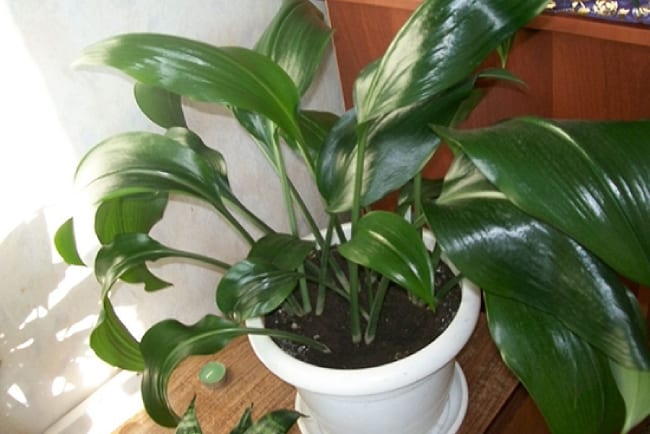 Indoor lily without flowers
Indoor lily without flowers
The buds may not appear for the following reasons:
- Lack of moisture in the ground, air. Care - water more often, spray the plant.
- Changes in temperature, which leads to rotting of the bulbs. Keeping lilies in a room with a constant mild climate will help to avoid this.
- Lack of light, fresh air. The solution is to move the lily to a well-ventilated area with bright, diffused light.
- Too wide a pot in which children grow, green mass. The solution is to transplant a lily into a smaller container.
- Lack of a dormant period. Leaving - move the pot to a cool, shaded place in the fall.
Why do lily leaves dry
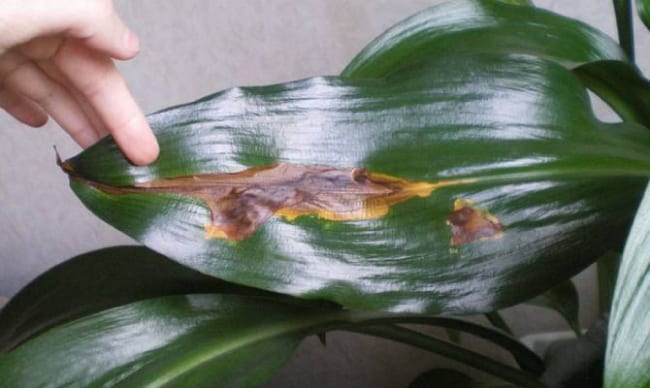 Dried leaf of home lily
Dried leaf of home lily
This problem is the most common. A change in the color of the foliage indicates the following:
- Autumn has come, so the yellowing of the greenery is natural. Caring for lilies at home is traditional - preparing for rest, keeping the flower in the cold.
- Damp foliage can be exposed to direct sunlight, causing burns. You need to move the pot to a room with diffused light, water or spray the plant in the evening or early morning.
- Dry air. Care - place a humidifier and a container of water next to the lilies. In addition, the flower pot can be placed on moistened stones, expanded clay, moss.
- Lack of nutrition leads to disruption of the process of photosynthesis, the suspension of the production of chlorophyll. When plants are actively developing, saturate them with complex compounds. When leaving, mixtures with a high content of potassium and iron are especially recommended: 2 tsp. citric acid + 7-9 g of ferrous sulfate + 3 liters of cool water.
Planting and transplanting recommendations

This plant does not like when the root system is disturbed. Therefore, it is necessary to transplant no more than 1 time in 3-4 years. In the process of this event, the flower should be transferred by transshipment to a new flowerpot along with an old lump of earth.
It is better to choose a new pot wider than deep. The composition of the soil mixture can be made by hand. To do this, mix until homogeneous 1 part of peat, 1 part of sifted river sand and 2 parts of compost soil.

There is an option: in equal proportions you need to take leafy, soddy and fibrous - peat soil. You can also add a small amount of rotted manure and river sand.
Put a drainage layer (2 - 3 cm) on the bottom of the pot, then install the onion. Then add soil little by little and compact. The bulb should be buried 4 to 5 cm from the edge of the pot.
The plant has such a feature: the children are not separated from the main bush. If they are planted separately, then they will not bloom later. A part is separated for reproduction, where there are at least 4 - 5 children.
Transplanting eucharis at room conditions
Eucharis transplant is carried out immediately after purchase. Young flowers need annual soil changes, while mature flowers can grow in one pot for about 3-4 years. Experts recommend replanting eucharis in mid-spring, when the plant has left the dormant phase and entered the rapid growth phase. Florists do not recommend replanting the plant during the flowering period, which would threaten to injure the flower and fall off the color.
A very important point is the selection of a new pot. The capacity should not significantly exceed the size of the previous one, so that the flower does not spend all its energy on growing roots
It is very important that there are drainage holes at the bottom of the pot.

You can also plant several bulbs or plants in one large pot at once.
When planting the bulb, it is important that the tip is above the substrate. One of the most important points in transplanting is the preparation of the soil, which should contain leafy soil, sand, peat and a little humus.
Pumice or foam is placed on the bottom of the container as a drainage layer. The upper part of the substrate is always compacted.
First of all, you need to loosen the soil in the pot and lay the plant on the surface. Entangled roots can be moistened with water to make them easier to examine. After a complete inspection, the damaged areas are cut off by treating with crushed coal or special means. In a new container, the plant is placed a few centimeters below the substrate level. The transplanted flower is looked after as usual. In some cases, the first flowering after transplanting may not be very abundant.
Eucharis - home care
Since the Amazonian lily is an unpretentious plant, even a beginner in this business can take care of it. That is why eucharis is often recommended for beginners in flower care. At the same time, the cultivation of the plant arouses a certain interest, which attracts even experienced owners.
Illumination and temperature conditions
Any lighting is suitable for an indoor eucharis flower, but it is better to protect it from direct sunlight, otherwise the plant may burn itself.
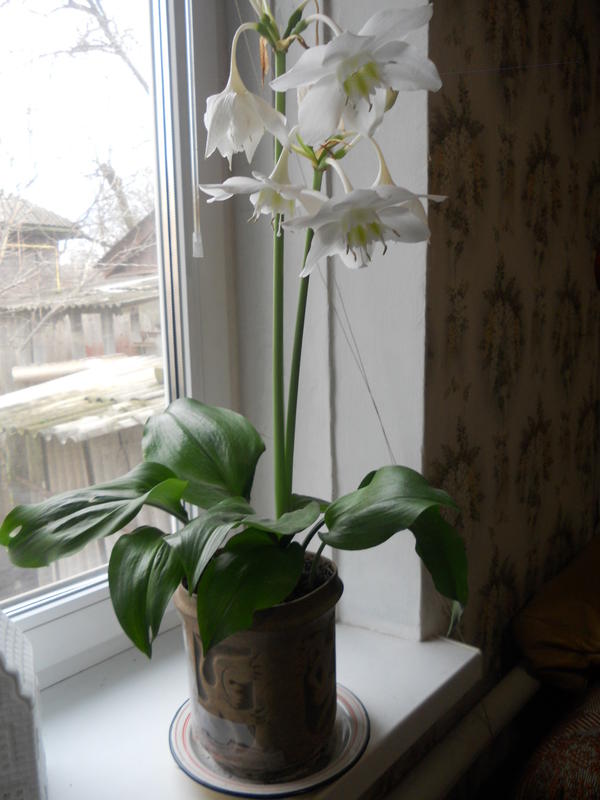
Amazon lily will feel good on the windowsill
The optimum temperature for flowering is a thermometer reading at +18 .. + 20 degrees. In this temperature setting, the Amazonian lily will feel best. In winter, the temperature can be slightly reduced - +16 .. + 18 degrees will be enough for the proper development of the plant.
Important! It is imperative to make sure that no drafts fall on the flower. It is also important to consider that with a sharp change in temperature, the plant will begin to feel uncomfortable and may slow down in growth and development.
Watering rules and humidity
The plant needs to be watered a couple of times a week. In this case, you must always monitor the state of the substrate - it must not be allowed to drain, but between watering it must have time to dry out. Also, liquid should not be allowed to stagnate, otherwise the plant will rot. The drainage layer in the pot is made at least 7-10 centimeters.
Eucharis prefers medium or high humidity, but you should not specifically raise it. It is best to spray it several times a week with room temperature water from a spray bottle.
When the flower begins to form peduncles, spraying must be stopped until the end of flowering - water should not get on the flowers and buds.
Top dressing and soil quality
Top dressing is an important part of eucharis care. It is necessary to feed the flower only during the period of active growth. For this, any mineral fertilizers for bulbous plants are suitable.
At the same time, it is important to pay attention to the nitrogen content in fertilizers - it should be as low as possible.
Attention! Often there is no need to feed the plant - once every two weeks will be enough. The soil must be fertile and loose
The easiest way to find the right soil is in the store - you should pay attention to the mark "for the Amaryllis family." To make the soil yourself, you need a mixture of peat, sand and humus in equal proportions
The soil must be fertile and loose
The easiest way to find the right soil is in the store - you should pay attention to the mark "for the Amaryllis family." To make the soil yourself, you need a mixture of peat, sand and humus in equal proportions
Flower container size
To grow and develop properly, eucharis needs a fairly tight pot. For one plant, you will need a pot with a diameter of about 15 centimeters and a height of at least 15 cm. The pot must be strong and stable so that it can withstand the weight of the plant's leaves.
Pruning and replanting
The Amazonian lily is the flower that does not like to be disturbed. That is why it is not recommended to transplant or cut the flower more than once every two to three years.
Attention! It is only necessary to transplant a flower if it has filled the entire pot and it does not have enough space. If the time has already come, you need to do this only during the rest period.
You should disassemble the transplant process step by step:
If the time has already come, you need to do this only during the rest period. You should disassemble the transplant process step by step:
- Remove the eucharis from the old pot.
- Clear the top root layer from the earth.
- Spread the drainage along the bottom of the container.
- Pour soil into a new pot in a layer of 10 cm over the drain.
- Place eucharis in the soil so that the root system expands and fills in all the gaps.
- Cover the plant with earth.
- Drizzle with water at room temperature.
The process of transplanting eucharis is quite simple - with due care and accuracy, there will be no problems.
Useful tips for flower growers
During the flowering period, the plant prefers abundant light, but not partial shade.
If you plant one bulb in a pot, then flowering can only be expected after 3-5 years.
You need to start feeding after 1-1.5 months. after transplant.
Why eucharis does not bloom, and what to do to make it bloom
Flowering is usually absent due to a shortage or improperly organized dormancy period. Rotting of roots and bulbs is also possible, which can only be noticed by removing the flower from the ground. You can correct the situation - if the flower was given an unsuitable dormancy period, then it must be properly organized and wait for flowering for the next season.
If the bulbs rot, then they are taken out of the pot and dried on a newspaper under diffused light for several days.Then the decayed part is cut off and sprinkled with coal. Then they are planted in a pot and adhere to the above recommendations. Eucharis may not bloom due to the larvae of mushroom mosquitoes or other insects living in the bulb.
As a radical option, you can consider the following actions to stimulate flowering: do not water for a month and keep at a temperature of +15 ºС, then water when the leaves begin to wither slightly. After this month, water with warm water (36 ºС) and heat the soil. For an adult flower, this procedure can be done up to three times a year, for a young one - one.
Why does the plant wither and turn yellow leaves
This is a normal process for a flower, but only if a few leaves wither and fall off. The reason for this phenomenon is often either overdrying of the soil, or abuse of watering. Hypothermia can also cause wilting and yellow leaves. Observe the environmental conditions and try to correct errors.
For dessert, we invite you to get acquainted with the video clip, which shows in great detail the process of flowering of the wonderful “Amazonian lily”. Enjoy your viewing, friends, and may your home flowers bring joy to your house!
Frequent mistakes in the care of eucharis
During the dormant period, it is necessary to reduce watering to a minimum. At this time, water is not poured, as usual, into the pan, but the soil is sprayed from a spray bottle, very carefully
It is also important to take the pot out of the sun into the shade and lower the temperature by a few degrees.
If the foliage has lost its elasticity, then watering the situation may not fix it. The cause is a draft and hypothermia. In this case, it is worth removing the sluggish leaves, and creating ideal conditions for the bulb to restore: put it in a warm place, feed it, watch out for the absence of drafts.
Why eucharis leaves turn yellow and die
Leaves can curl and wither not only from exposure to a draft, but also due to damage to the roots. Yellowing and shrinking is a natural process when it touches the outer leaves, but not all at the same time. The reasons may be different:
- too abundant or weak watering;
- too cold (temperature 10 ° C and below);
- sunburn.

Yellowed eucharis leaf
The damaged plant is removed from the pot, washed, dried. Treat the damage with ash and plant it again in a pot, filling it with fresh nutrient soil.
Why eucharis does not bloom at home and how to make it shoot an arrow
The reasons for the growth of green mass and the absence of peduncles can be as follows:
- landing incorrectly. The container is too wide. The tighter the bulb is in the pot, the sooner it will throw out the peduncle;
- too sharp jump in temperature in the room. In this case, the flower arrows are formed weak, and the bulb can even rot;
- there is no rest period. Its optimal duration is 1.5 months. At this time, they stop feeding, and watering is done moderately. The soil should always be half dry.
Types of Amazonian lily
In nature, there are more than 20 varieties of this species. Representatives of the family easily interbreed with each other in natural conditions, which complicates the classification. Breeders have bred many hybrid species of not only street plants, but also indoor plants, which inherited only the best traits from their parents:
-
One of the most common species is the Large-flowered eucharis. The flower has bulbs, on average 3-5 cm in diameter, from which large dark green leaves grow. From the very middle of the bulb, a peduncle grows about 70 cm in height, on which 5-6 buds flaunt.
Flowers about 10-12 cm have a greenish tube and white petals with a pointed edge and snow-white color. The buds exude a very pleasant, sweet aroma. Brown stamens grow from the core. The variety blooms from late summer to mid-winter.
-
No less attractive is the eucharis Sandera, which amazes with its large size.The flower has oblong bulbs about 7 cm in diameter. It has large dark green leaves up to 18 cm wide and up to 30 cm long on a long petiole that can grow up to 10-15 cm.
It has an erect thick peduncle, on which several large buds and up to 5-6 small ones usually grow. Flowers bloom in white alternately. The elongated part of the flower has a yellowish tint. Flowering occurs at the end of winter.
- Eucharis White is considered to be no less popular. It differs from the rest of the representatives by an egg-shaped bulb up to 5 cm in size and wide oval leaves 10-15 cm wide and up to 40 cm long, with a short petiole at the base. The peduncle is massive, with a brownish tint, up to 10 buds are located at the end, which bloom in white by the end of March. The elongated part of the flower is beige, and the pointed petals are white.
It will also be interesting: Alsobia - caring for a houseplant at home?
Eucharis plant during flowering (with photo)
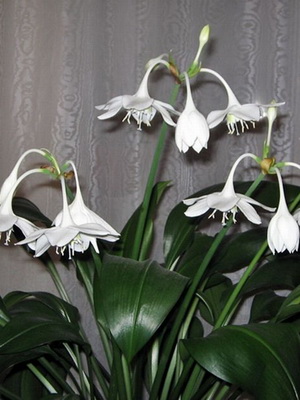
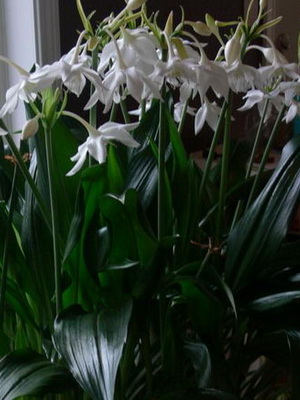
The Amazonian lily has globular bulbs covered with gray-brown scales, reaching 5 cm in diameter. In the description of the eucharis flower, its name is translated as "adorable", and this applies not only to its flowers, but also to the lush foliage. Dark green glossy leaves grow on thin stems and have a wide oval shape. The leaves reach 15 cm in width, and the petioles grow up to 30 cm in length. A groove runs along the center of the sheet, protruding from the bottom as a dense roller, and across the sheet there are clearly visible veins, which give the sheet a roughness to the touch. Each eucharis leaf is short-lived, growing no more than 1.5 years. Leaves are renewed gradually.
Before flowering, the eucharis plant produces a long peduncle, reaching 80 cm in length. The umbrella-shaped inflorescence develops within 2 weeks and contains 5 snow-white flowers, each up to 12 cm in diameter. It blooms twice a year - in late spring and early autumn.
The flowers bloom alternately and have a pleasant aroma. In some species, the number of flowers can reach 10 pieces, and the core can be yellow or green. And although the plant has the name "lily", but visually its flower looks more like a daffodil. The flowering period can last up to 30 days, the culmination of which is the formation of a fruit - a three-lobed capsule with numerous seeds.
Take a look at the photo of what the eucharis plant looks like:
